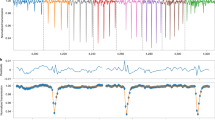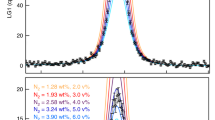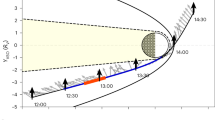Abstract
The detection of methane on Mars has been interpreted as indicating that geochemical or biotic activities could persist on Mars today1. A number of different measurements of methane show evidence of transient, locally elevated methane concentrations and seasonal variations in background methane concentrations2,3,4,5. These measurements, however, are difficult to reconcile with our current understanding of the chemistry and physics of the Martian atmosphere6,7, which—given methane’s lifetime of several centuries—predicts an even, well mixed distribution of methane1,6,8. Here we report highly sensitive measurements of the atmosphere of Mars in an attempt to detect methane, using the ACS and NOMAD instruments onboard the ESA-Roscosmos ExoMars Trace Gas Orbiter from April to August 2018. We did not detect any methane over a range of latitudes in both hemispheres, obtaining an upper limit for methane of about 0.05 parts per billion by volume, which is 10 to 100 times lower than previously reported positive detections2,4. We suggest that reconciliation between the present findings and the background methane concentrations found in the Gale crater4 would require an unknown process that can rapidly remove or sequester methane from the lower atmosphere before it spreads globally.
This is a preview of subscription content, access via your institution
Access options
Access Nature and 54 other Nature Portfolio journals
Get Nature+, our best-value online-access subscription
$29.99 / 30 days
cancel any time
Subscribe to this journal
Receive 51 print issues and online access
$199.00 per year
only $3.90 per issue
Buy this article
- Purchase on Springer Link
- Instant access to full article PDF
Prices may be subject to local taxes which are calculated during checkout



Similar content being viewed by others
Data availability
The datasets generated by the NOMAD and ACS instruments and analysed during the current study will be available in the ESA Planetary Science Archive repository, https://archives.esac.esa.int/psa, after the six months prior access period, following the ESA Rules on Information, Data and Intellectual Property. The data used for the figures are available on request from the corresponding author.
Code availability
The computer codes used to decipher the upper limits of CH4 are available on request from the corresponding author.
Change history
17 April 2019
The surname of author Cathy Quantin-Nataf was misspelled ‘Quantin-Nata’, authors Ehouarn Millour and Roland Young were missing from the ACS and NOMAD Science Teams list, and minor changes have been made to the author and affiliation lists; see accompanying Amendment. These errors have been corrected online.
References
Yung, Y. L. et al. Methane on Mars and habitability: challenges and responses. Astrobiology 18, https://doi.org/10.1089/ast.2018.1917 (2018).
Mumma, M. J. et al. Strong release of methane on Mars in northern summer 2003. Science 323, 1041–1045 (2009).
Webster, C. R. et al. Mars methane detection and variability at Gale crater. Science 347, 415–417 (2015).
Webster, C. R. et al. Background levels of methane in Mars’ atmosphere show strong seasonal variations. Science 360, 1093–1096 (2018).
Giuranna, M. et al. Independent confirmation of a methane spike on Mars and a source region east of Gale Crater. Nat. Geosci. http://www.nature.com/articles/s41561-019-0331-9 (2019).
Lefèvre, F. & Forget, F. Observed variations of methane on Mars unexplained by known atmospheric chemistry and physics. Nature 460, 720–723 (2009).
Zahnle, K., Freedman, R. S. & Catling, D. C. Is there methane on Mars? Icarus 212, 493–503 (2011).
Viscardy, S., Daerden, F. & Neary, L. Formation of layers of methane in the atmosphere of Mars after surface release. Geophys. Res. Lett. 43, 1868–1875 (2016).
Krasnopolsky, V. A., Maillard, J. P. & Owen, T. C. Detection of methane in the Martian atmosphere: evidence for life? Icarus 172, 537–547 (2004).
Formisano, V., Atreya, S., Encrenaz, T., Ignatiev, N. & Giuranna, M. Detection of methane in the atmosphere of Mars. Science 306, 1758–1761 (2004).
Villanueva, G. L. et al. A sensitive search for organics (CH4, CH3OH, H2CO, C2H6, C2H2, C2H4), hydroperoxyl (HO2), nitrogen compounds (N2O, NH3, HCN) and chlorine species (HCl, CH3Cl) on Mars using ground-based high-resolution infrared spectroscopy. Icarus 223, 11–27 (2013).
Krasnopolsky, V. Search for methane and upper limits to ethane and SO2 on Mars. Icarus 217, 144–152 (2012).
Zahnle, K. Play it again, SAM. Science 347, 370–371 (2015).
Etiope, G. & Sherwood Lollar, B. Abiotic methane on Earth. Rev. Geophys. 51, 276–299 (2013).
Oehler, D. & Etiope, G. Methane seepage on Mars: where to look and why. Astrobiology 17, 1233–1264 (2017).
Vago, J. et al. ESA ExoMars program: the next step in exploring Mars. Sol. Syst. Res. 49, 518–528 (2015).
Svedhem, H. et al. The ExoMars Trace Gas Orbiter. Space Sci. Rev. (in the press).
Korablev, O. et al. The Atmospheric Chemistry Suite (ACS) of three spectrometers for the ExoMars 2016 Trace Gas Orbiter. Space Sci. Rev. 214, 7 (2018).
Vandaele, A. C. et al. NOMAD, an integrated suite of three spectrometers for the ExoMars Trace Gas mission: technical description, science objectives and expected performance. Space Sci. Rev. 214, 80 (2018).
Vandaele, A. C. et al. Martian dust storm impact on atmospheric water and HDO/H2O observed by ExoMars Trace Gas Orbiter. Nature https://www.nature.com/articles/s41586-019-1097-3 (2019).
Fedorova, A. et al. Water vapor in the middle atmosphere of Mars during the 2007 global dust storm. Icarus 300, 440–457 (2018).
Mischna, M. A., Allen, M., Richardson, M. I., Newman, C. E. & Toigo, A. D. Atmospheric modeling of Mars methane surface releases. Planet. Space Sci. 59, 227–237 (2011).
Waugh, D. W., Toigo, A. D. & Guzewich, S. D. Age of martian air: time scales for martian atmospheric transport. Icarus 317, 148–157 (2019).
Tyler, D. & Barnes, J. R. Convergent crater circulations on Mars: influence on the surface pressure cycle and the depth of the convective boundary layer. Geophys. Res. Lett. 42, 7343–7350 (2015).
Vasavada, A. R. et al. Assessment of environments for Mars Science Laboratory entry, descent, and surface operations. Space Sci. Rev. 170, 793–835 (2012).
Clancy, R. T., Sandor, B. J. & Moriarty-Schieven, G. H. A measurement of the 362 GHz absorption line of Mars atmospheric H2O2. Icarus 168, 116–121 (2004).
Clancy, R. T. et al. Daily global mapping of Mars ozone column abundances with MARCI UV band imaging. Icarus 266, 112–133 (2016).
Smith, M.D. et al. The climatology of carbon monoxide and water vapor on Mars as observed by CRISM and modeled by the GEM-Mars general circulation model. Icarus 301, 117–131 (2018).
Trompet, L. et al. Improved algorithm for the transmittance estimation of spectra obtained with SOIR/Venus Express. Appl. Opt. 55, 9275–9281 (2016).
Liuzzi, G. et al. Methane on Mars: new insights into the sensitivity of CH4 with the NOMAD/ExoMars spectrometer through its first in-flight calibration. Icarus 321, 671–690 (2019).
Maltagliati, L. et al. Annual survey of water vapor vertical distribution and water–aerosol coupling in the Martian atmosphere observed by SPICAM/MEx solar occultations. Icarus 223, 942–962 (2013).
Rodgers, C. D. Inverse Methods for Atmospheric Sounding Vol. 2 (World Scientific, 2000).
Gordon, I. E. et al. The HITRAN2016 Molecular Spectroscopic Database. J. Quant. Spectrosc. Radiat. Transf. 203, 3–69 (2017).
Millour, E. et al. The Mars Climate Database (MCD version 5.2). European Planetary Science Congress 2015 abstr. EPSC2015-438 http://meetingorganizer.copernicus.org/EPSC2015/EPSC2015-438.pdf (2015).
More, J., Garbow, B. & Hillstrom, K. User Guide for MINPACK-1 Technical Report ANL-80-74 (Argonne National Laboratory, 1980).
Webster, C. R. et al. Low upper limit to methane abundance on Mars. Science 342, 355–357 (2013).
Steele, L. J., Balme, M. R., Lewis, S. R. & Spiga, A. The water cycle and regolith–atmosphere interaction at Gale crater, Mars. Icarus 289, 56–79 (2017).
Lefèvre, F. & Krasnopolsky, V. in The Atmosphere and Climate of Mars (ACM2017) (ed. Haberle, R. M.) 374–404 (Cambridge Univ. Press, 2017).
Acknowledgements
ExoMars is the space mission of ESA and Roscosmos. The ACS experiment is led by IKI, the Space Research Institute in Moscow, assisted by LATMOS in France. The project acknowledges funding by Roscosmos and CNES. The science operations of ACS are funded by Roscosmos and ESA. IKI affiliates acknowledge funding under grant number 14.W03.31.0017 and contract number 0120.0 602993 (0028-2014-0004) of the Russian government. The NOMAD experiment is led by the Royal Belgian Institute for Space Aeronomy (BIRA-IASB), assisted by co-PI teams from Spain (IAA-CSIC), Italy (INAF-IAPS), and the UK (Open University). This project acknowledges funding by the Belgian Science Policy Office (BELSPO), with the financial and contractual coordination of the ESA Prodex Office (PEA 4000103401 and PEA 4000121493), by Spanish MICINN through its Plan Nacional and by European funds under grants ESP2015-65064-C2-1-P and ESP2017-87143-R (MINECO/FEDER), as well as by the UK Space Agency through grants ST/R005761/1, ST/P001262/1, ST/R001405/1, ST/S00145X/1, ST/R001367/1, ST/P001572/1 and ST/R001502/1, and the Italian Space Agency through grant 2018-2-HH.0. This work was supported by the Belgian Fonds de la Recherche Scientifique—FNRS under grant number 30442502 (ET_HOME). We are indebted to the large number of people responsible for designing, building, testing, launching, communicating to and operating the spacecraft and science instruments, whose efforts made the success of TGO possible.
Reviewer information
Nature thanks Jonathan Lunine, John Moores, Kevin Zahnle and the other anonymous reviewer(s) for their contribution to the peer review of this work.
Author information
Authors and Affiliations
Consortia
Contributions
O.K., A.C.V. and F.M. conceived the study, collected inputs and wrote the paper. A.A.F. calibrated the ACS data and analysed the profiles (assisted by A.T., K.S.O. and J.A.). The ACS dataset was prepared by A.T. (assisted by L.B., J.A. and Y.S.I.). A.T., A.V.G., N.I.I., A.S. and A.P. designed the ACS observations. D.A.B. analysed the ACS CO2 data. F.M. derived the methane detection limits from ACS. I.R.T. analysed the solar occultation data and provided transmittances from the NOMAD SO channel. J.T.E. and L.T., with S.A., derived the NOMAD methane detection limits. The initial General Circulation Model fields were provided by L.N. and F.D., and J.T.E. and S.R. provided and analysed the a priori knowledge and initial General Circulation Model fields. C.D. and Y.W. were involved in UVIS calibration and the data pipeline. B.R., B.B., C.Q. and E.N. designed the NOMAD observations, helped by J.M. for the UVIS channel. L.H., S.B. and R.C. are responsible for the uplink and downlink of telemetry and science data, and the first conversion of those data. M.R.P., G.B. and J.-J.L.-M. provided support in the selection of the NOMAD observations on the basis of their scientific interest. F.F., F.L. and F.D. provided critical inputs regarding the model chemistry and circulation (assisted by J.-L.B. L.N., S.V. and G.E.). C.F.W., L.Z., H.S. and J.L.V. coordinated observations of the various instruments on TGO. All authors contributed to the preparation of the manuscript.
Corresponding author
Ethics declarations
Competing interests
The authors declare no competing interests.
Additional information
Publisher’s note: Springer Nature remains neutral with regard to jurisdictional claims in published maps and institutional affiliations.
Extended data figures and tables
Extended Data Fig. 1 A sequence of transmittance spectra measured with the ACS MIR channel.
The spectra are for an example orbit (Lsolar = 180.9°) obtained using the secondary grating position 12 (ref. 17). Different diffraction orders (top axis) are denoted by the changing colour of the transmission curves, and their numbers are indicated on the upper scale. Diffraction orders used in this study are 178 (for CO2), 180 (the CH4 Q-branch), and 182 (the CH4 R-branch). Enhanced extinction on the short wavelength edge of the spectra is due to H2O ice absorption.
Extended Data Fig. 2 Retrieval of trace gases from ACS MIR spectra using Rodger’s regression.
The spectra are for one aerosol-free polar case (upper panels), and for a more cloudy low-latitude case (lower panels). Both occultations were observed before the global dust event. Left-hand-side panels show water vapour profiles retrieved using faint H2O absorption lines separately in diffraction orders 180 and 182. Middle panels show attempts to retrieve CH4 in the same diffraction orders (order 180 gives access to the CH4 Q-branch, and order 182 to the CH4 R-branch). Curves with error bars indicate the regularized profiles (denoted as Tikhonov Qb). The error bars give the 1σ uncertainty on the retrieved parameters. To illustrate the accuracy for the individual spectra, the regularization was also turned off (scatter points). Right-hand-side panels show profiles for the optical depth on the line of sight (red), and of the SNR in the MIR spectra (black). The SNR for each spectrum was calculated over the whole diffraction order, excluding spectral intervals with gaseous features.
Extended Data Fig. 3 Theoretical relation between the instrument SNR and the methane detection limit, and the step-by-step outputs of the CH4 retrieval.
Top panel, the theoretical relation between SNR per pixel and the retrieved 1σ uncertainty on the CH4 line-of-sight density expressed in units of molecules per cm2. At SNR >1,000 per pixel, the associated uncertainty is 1014 molecules per cm2, which would yield an equivalent vmr uncertainty of 0.1 p.p.b.v. of CH4 in the 10-km altitude range where the CO2 density is usually around 1024 molecules per cm2. Bottom panels (from left to right), altitude profiles of SNR per pixel (left), CO2 and the error on the CH4 line-of-sight (LOS) density in units of cm−2 (middle) and the resulting upper limits retrieved for CH4 molecules (right). The displayed observation corresponds to high northern latitudes after the equinox (Lsolar 192°; 13 June 2018). The prevailing clear conditions allowed sounding very close to the surface with high SNR, yielding optimal conditions for the retrieval of CH4. The black, red and blue colours refer respectively to CO2 (in order 178), CH4 (in order 180) and CH4 (in order 182).
Extended Data Fig. 4 A compilation of all the retrieved upper limits from the ACS-MIR dataset covering the period from 21 April to 4 September 2018.
Top, limits from the Q-branch of CH4 absorption; bottom, limits from the R-branch of CH4 absorption. The colour scale denotes Lsolar. Different symbols of similar colour designate individual profiles.
Rights and permissions
About this article
Cite this article
Korablev, O., Vandaele, A.C., Montmessin, F. et al. No detection of methane on Mars from early ExoMars Trace Gas Orbiter observations. Nature 568, 517–520 (2019). https://doi.org/10.1038/s41586-019-1096-4
Received:
Accepted:
Published:
Issue Date:
DOI: https://doi.org/10.1038/s41586-019-1096-4
This article is cited by
-
Tunable Laser Spectrometers for Planetary Science
Space Science Reviews (2023)
-
Space-qualified, compact and lightweight pulsed DPSS UV laser for the MOMA instrument of the ExoMars mission
CEAS Space Journal (2023)
-
Dynamics and clouds in planetary atmospheres from telescopic observations
The Astronomy and Astrophysics Review (2023)
-
JWST’s quest for indications of life on planets and exoplanets
Nature Astronomy (2022)
-
Mission Overview and Scientific Contributions from the Mars Science Laboratory Curiosity Rover After Eight Years of Surface Operations
Space Science Reviews (2022)
Comments
By submitting a comment you agree to abide by our Terms and Community Guidelines. If you find something abusive or that does not comply with our terms or guidelines please flag it as inappropriate.



